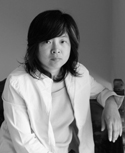LIU YAN
Images | Biography | Artist Statement | Exhibitions and Press
2011

2010

2009

2008

2007

Early Works


Liu Yan's works combine the materials and techniques of traditional Chinese painting with Western representational modes and imagery. In the six works exhibited here, Liu Yan creates a collage-like painting surface from China's cultural detritus: pages of old books, gold foil, mulberry paper and reproductions of famous imperial portraits of a Qing Emperor and Empress. She then works in a pastiche of imagery and icons from traditional China and contemporary international popular culture, revealing the tensions that lie beneath China's integration into global culture. Rock and roll stars with mohawk hairstyles, punk costumes and spike collars painted in neon colors are juxtaposed with Peking opera actors. Their exaggerated expressions and postures resonate with the masked, elaborately costumed opera figure, erstwhile stars of pre-revolutionary China. The Peking opera actor appears mournful, perhaps witnessing his demise as a cultural icon.
Changing gender roles and sexual desire also figure prominently in Liu Yan's work. Women wearing the dress and chignons of Imperial China are rendered in traditional ink painting technique, their bodies hidden by their flowing robes. By contrast, the bodies of modern-day women are revealed in various states of dress and undress. A Western woman in a short frock and high heels bends over provocatively. A more demurely dressed woman touches the shoulder of a half-naked woman who looks out from behind a Peking opera mask. In Enjoyment in Destruction, a bare-chested woman clutches her breasts and screams, her face bound with rope. All of these images suggest the unleashing of repressed sexual desire. Traditional figures look on, eyes bulging, mouths open in dismay. The highly animated calligraphic line of their robes is evocative of their disturbed emotional state.
In The Man's World and The Woman's World, Liu Yan uses the highly formal mode of imperial portraiture to signify gender roles in traditional China. Supreme emblems of dynastic China's state and society, the Emperor and Empress, are represented frontally and symmetrically seated on elaborate thrones. All traces of their bodies and their sexuality are hidden by imperial robes and headdresses. Their dignified role as exemplars of social decorum and political power is violated by the debauched behavior of the figures around them. Barely clad women straddle the imperial couple's laps. They are surrounded by a rogues' gallery of modern icons of political and cultural power including Mao Zedong and his wife, Jiang Qing, Salvador Dali and Madonna. In The Woman's World, two women in court garb kiss while a female People's Liberation Army soldier aims her gun at the forces of desire that threaten to overwhelm traditional Chinese culture and values.
The layered cultural references and jarring juxtapositions of Liu Yan's work reveal the tensions beneath changing attitudes towards desire and the collision of cultures in a global age.

All artists believe that having an artistic "language" of their own is important. After years of practice, finding my personal art language is no longer a struggle. Instead, the challenge comes from finding an artistic "vision." My vision has developed from my attitude, which determines the concept, as well as theme and language. Only after having one's own life experiences, do we truly understand our own visual language. An outstanding work of art is touched by the soul and emotions of the artist, and is developed with their personal perspective. When the artist falls in love with their work, the viewer will understand and appreciate their dedication. -- Liu Yan